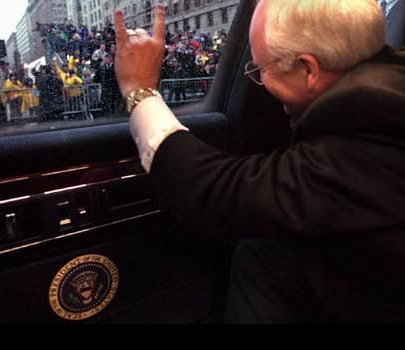
There is one book that explains the Bush presidency just about better than any other I have read — and it hardly deals with Bush. It focuses on Vice President Cheney’s all-but-in-name presidency.
Barton Gellman’s Angler: The Cheney Vice Presidency deserves another Pulitzer on top of the one that Gellman and co-author Jo Becker already won in 2008 for their riveting four part series on Cheney, his team, and their surprisingly large impact on the nation’s economic and national security positions.
I reviewed the book for this month’s American Conservative magazine. The entire essay is linked here but here is an excerpt for others:
The curious way in which Cheney maneuvered himself onto Bush’s ticket is one of many disturbing stories in this new and brilliantly researched account of Cheney’s adventures as Bush’s “No. 2.” Barton Gellman, Pulitzer-winning Washington Post journalist, examines the nuts and bolts of Cheney’s power apparatus. He shows how a mere vice president engineered a massive expansion of presidential power, knocked back the constitutional authority of Congress and the judiciary, helped launch an illegitimate war, developed a system for spying on America’s citizens, oversaw White House-sanctioned torture, and pushed official secrecy to unprecedented levels. We see how Cheney punctured America’s mystique as a benign and respected nation–how he shattered the moral, economic, and military pillars of American power.
Gellman had access to a surprising number of Cheney’s close aides and others in the Bush White House. He records previously unknown anecdotes about the inner workings of the administration and Cheney’s take-no-prisoners approach to winning policy battles. While Bush and members of his inner circle like Karl Rove seemed to be obsessed with the political machinations of their work, Cheney had a deeper purpose behind his crusades. For him politics and political gamesmanship, seduction, and intimidation were all about changing the nation’s policy course–all about principle. Cheney wasn’t much interested in weather politics. When Bush ordered him to survey Hurricane Katrina’s damage, he reluctantly complied. But his heart and soul were invested in the most important and controversial aspects of the Bush presidency, the policy areas he cared about most–terrorism, intelligence, national security, energy, environmental policy, tax and budget issues.
Gellman makes the fascinating and convincing claim that Cheney’s notorious secret meetings with energy lobbyists, which prompted legal complaints from various NGO’s, Congress, and the U.S. Government Accountability Office, were never about anything important. Cheney and his abrasive lawyer David Addington wanted to bring on governmental crises and tensions with Congress in order to demonstrate the dominance and infallibility of presidential power, which they defined as the “unitary executive.” In Gellman’s framing, Cheney saw 9/11, discussions with energy lobbyists, and even torture policy as mere vehicles for asserting his vision of a near monarchial presidency.
Angler leads its readers to think that, even without 9/11, Cheney would have found triggers to justify his imperial expansion of presidential powers and official secrecy, his pugnacious disregard for international law, the huge defense spending increases, the war against Iraq–or whatever nation would show that America was an irresistible force–and the massive tax cuts. Gellman argues that Cheney was never an apostle of neoconservatism. He didn’t have a burning desire to establish democracy in Iraq. For Cheney, John Bolton, Addington, and others, Iraq was but a means to an end–a tool to expand presidential prerogatives. The same does not necessarily apply to Scooter Libby, a leading neoconservative thinker who strongly favored the invasion for ideological reasons.
This book is simply one of the scariest stories ever written about contemporary America. Cheney and Addington essentially hijacked the bureaucracy of national security and put themselves in the cockpit of government. In chapter after chapter, we read how Cheney set about constructing a secretive system of government and policymaking in which he was accountable to almost no one. We see, for instance, how Cheney pushed through the second round of tax cuts–a move that made even Bush uncomfortable–and how he undermined Christine Todd Whitman, then administrator of the Environmental Protection Agency, over laws regarding air quality.
In contrast to the protagonist and his agents, there are heroes. John Bellinger, a senior lawyer on the National Security Council and then at the State Department under Condoleezza Rice, fought for the interests of Congress and international law. For that, he was beleaguered by Addington and frozen out of the conspiracy to create the legal rationalization for the domestic electronic eavesdropping program. He has nonetheless stayed in the game for the last seven years, trying to bring about a return to Geneva-like standards and end the administration’s extralegal detainee policies.
[For more, read here.]
Bravo to Joe Biden who during his debate with Sarah Palin said how it was with Cheney. Biden called him “one of the most dangerous vice presidents in America’s history.”
Gellman’s book tells you why. It’s a must read.
— Steve Clemons


31 comments on “Cheney Rerouted the In- and Out-Boxes of White House Power”